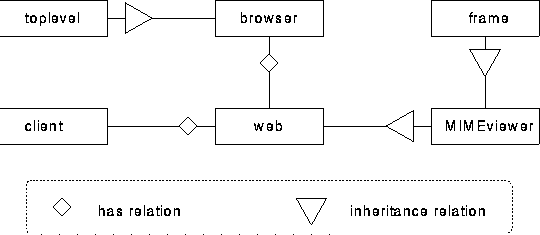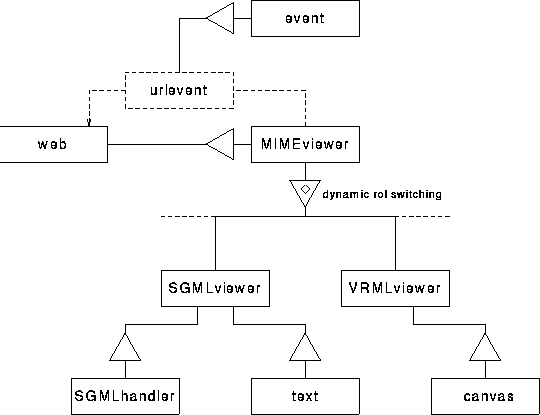Viewing the Web -- the Web Components
The hush class library offers two ways to connect
applications with the Web. Pages on the Web can be used as part
of an application by employing the web component, for
example for online help. On the other hand, these pages may
contain embedded applets, defined by the application.
Since most hush applications have a script interface as
well, the application itself may be (recursively) embedded within
such HTML documents [DoornEl95].
Requirements of the Web Components
The design of the Web-related components of the hush
library has been influenced by requirements such as extensibility
with new data formats, data transfer protocols and support for
active documents.
Data formats
The world of hyper- and multimedia abounds with data formats.
For each type of media, such as text, sound and video, a few data
formats play a prominent role. A Web browser should provide the
means to show these data formats. However, viewer applications,
separate from the browser, have some major drawbacks. For
example, users have to use different interfaces and following
links specified in a separate document is more difficult because
of the loose coupling between the viewer application and the main
browser.
A more elegant solution is to provide mechanisms to include the
viewers into the browser itself, since it allows for a more
uniform interface and for inlining the display of information, so
that the user does not have to switch to another toplevel window.
For example, it is possible to insert video fragments into an
HTML-page or even to insert an HTML-page into another HTML-page.
The ability to support multiple data formats has been a major
influence on the design of our Web components. At the moment our
browser supports HTML, SGML, VRML, video (including MPEG,
Quicktime, AVI) and a variety of image types. Developing new
viewers and including them as integrated components into the
framework is possible without much effort.
Data transfer protocols
The dominant communication protocol of the Web is currently
HTTP, but new or enhanced communication and network transfer
protocols will undoubtedly be needed. Examples include real-time
protocols to incorporate continuous multimedia streams or
protocols supporting safe data transfer. The DejaVu framework
provides a testbed to experiment with these new protocols by
plugging them into a Web environment.
Active documents -- client-side computing
A simple but powerful approach to active documents is to add
the ability to run applets (mini-applications). At the moment
our browser can execute Tcl-scripts (applets) that can be
inserted into HTML or SGML documents, and the design is
sufficiently open to add support for Java or Python applets as
well.
Architecture of the Web Components
To satisfy our requirements, we needed a flexible and open
design of the Web components. To achieve such flexibility and
extensibility, we made use of the idioms mentioned in section
[dejavu]. Recall that the virtual self-reference idiom
is used to realize nested components and the dynamic
role-switching idiom allows for multiple modes, for example to
display a variety of document formats.

slide: Overview
Figure [fig:overview] shows an overview of the basic
Web-related components of the hush library. The
browser provides the toplevel user interface for all Web
components, including a viewer, a scrollbar, navigation buttons
(back, forward, home, reload) and an entry box to enter URLs.
The client, web and MIMEviewer components
form the conceptual base of our approach of connecting to the
Web:
- client -- the interface to the World Wide Web,
supporting several protocols
- viewer -- a widget to display several MIME types, such
as HTML and VRML
- web -- an extension of the MIMEviewer with
connection to the Web, history of followed links and caching
slide: Components
Each component can be extended in a simple way.
The client component
The client component builds the bridge between the local
web widget and the World Wide Web by providing an abstract
and uniform interface to network (file) access and transport
protocols. Figure [fig:client] shows the design of the
client component.

slide: The client component
To be able to add specific clients for new
protocols, the dynamic role-switching idiom is used to implement
the client class. The client implicitly changes its
role, depending on the protocol required. The web widget
only knows about the (abstract) client class while the
actual functionality is implemented in several concrete
client classes, one per protocol.
When the client gets the instruction to retrieve a URL,
it inspects the URL and chooses the right protocol. In other
words, it changes its role to the appropriate protocol
implementation. The addition of new protocols can be done
without changing the web widget.
The viewer component
In the realization of the MIMEviewer components we have
employed the dynamic role-switching idiom in the same way as in
the implementation of the client component. The
MIMEviewer class offers a uniform interface to the
different viewers (see figure [fig:viewer]).

slide: Viewers
The user creates
a MIMEviewer object and tells which role it should play
(e.g. SGMLviewer or VRMLviewer). This role can be changed during
the lifetime of a single MIMEviewer object by calling a
method to change its role. A browser typically uses only one
MIMEviewer that changes its role according to the type of
data that should be displayed.
Since the MIMEviewer provides no network functionality
at all, it generates an event whenever it needs to retrieve data
pointed to by a URL. Such events are generated as a response to
user interaction (e.g. clicking an anchor) or to fetch inline
data during the parsing process. These events (realized by the
hidden urlevent class) are typically handled by a
web component.
The web component
A central role in our approach is played by the web
widget. It combines the functionality of the MIMEviewer
and the client components. It is able to follow links by
retrieving data via several protocols, a task delegated to its
client component. Additionally, the web component
adds a history and caching mechanism to the MIMEviewer.
The web component's behavior is similar to the standard
widgets of the framework, and can be conveniently used as a part
of an application's GUI. Because the web widget has both
a C++ class interface and a script interface, it is easy to
create, or extend, applications with Web functionality. Note
that the SGML viewer already allows for a rich variety of data
formats, possibly extending HTML.


